As probably most of us, I try to be environmentally conscious and recycle as much as possible – and also use products made from recycled things. This includes my crafting, and I am very excited that now more and more yarn brands offer yarns made from recycled fibers!
During a recent (online) yarn shopping, I came across ‘The Recycled Yarn’ from ‘we are knitters’, which is made from 95% recycled cotton and decided to give it a go. Because of its sturdiness, it is excellent for all things kitchen-related, such as dish towels and cloths.
Another recent find of mine is the Linen Stitch, which is a knit stitch that results in a woven-like texture. It works great for one, two or even three colors! Combine this with my need for some more dish towels in my kitchen, and tada – the Cottage Tea Towel is born!
- Add the ‘Cottage Tea Towel’ pattern to your Ravelry queue here
- Get ad-free, printable PDF pattern here
- Pin it to your Pinterest board here
Yarn
- DK weight yarn in two colors
- Yardage: 170yds each
- I used ‘The Recycled Yarn‘ by we are knitters in Natural and Sky Blue
Materials
- Size 6mm (US 10) knitting needles
- Tapestry needle
- Scissors
- Measuring tape
Gauge
24 sts in 4″ (10cm) using linen stitch
Row gauge is not critical.
Measurements
22” x 15” (56cm x 38cm)
Notes
- I highly recommend using a (non-mercerized) cotton yarn for this as cotton is sturdy, absorbent, and can also be machine-washed
- As of March 25. 2022, Ravelry lists The Recycled Yarn as a DK weight, and the ‘we are knitters ‘ online shop lists it as an Aran weight. In my opinon, it’s even on the thinner side for a DK, and when substituting another yarn to knit The Cottage Tea towel I recommend a DK over an Aran. But of course this towel can be knit with almost any yarn weight, just be sure to adapt needle size and number of stitches you cast on accordingly
- Gauge is not very critical, as it’s not a big deal if the towel is bit smaller or larger. However, I still recommend making a swatch to see if you are happy with the drape as the linen stitch tends to be tighter than other knit stitches. If it’s too loose, go down a needle size, if it’s too dense or stiff, go up a needle size
- US10 / 6mm needles might seem large for a DK yarn but due to the linen stitch being a combination of slipped and knit stitches, I found it necessary to use larger needles than usual to create a fabric that still has some drape
- If you want to modify the width of the towel, make sure to always cast on an odd number
- To alter the length, keep knitting until you reach the desired length
- I used a standard bind-off, and as the linen stitch results in a fairly tight fabric the bind off does not need to be very loose
- Make sure to knit the first stitch of every right-side row quite loosely, otherwise that side has a tendency to bunch up
About the Linen Stitch
The Linen Stitch is created with a combination of knitted and slipped stitches with the yarn held in front (of the right side) to create the impression of a woven fabric.
The right side will have stitches that are kind of interlocked, with little “bars” crossing them.
The wrong side is very different but also quite pretty and looks a bit like a seed stitch. It has a bit more surface area because of the loose strings, and it’s perfect for soaking up liquids.
It results in a flat fabric, and so it would also be great for coasters!
If you want to modify this pattern or create something else with the Linen Stitch, here are a couple of things to remember:
- Always cast on an odd number of stitches
- It is created by using a 2-row repeat:
- If knitting flat:
- *K1, slwyif 1* until 1 stitch before end of row, K1, turn
- slwyib 1, *P1, slwyib 1* until end of row, turn
- If knitting in the round
- *K1, slwyif 1* until 1 stitch before end of round, K1
- slwyif 1, *K1, slwyif 1* until end of round
- You can use as few or many colors as you wish
How to ‘Slip 1 with yarn in front / back’ (slwyif / slwyib)
To slip a stitch with yarn in front, hold your working yarn (blue in the picture) in front of your work, then slip the stitch purlwise.
To slip a stitch with yarn in back, hold your working yarn behind your work, then slip the stitch purlwise.
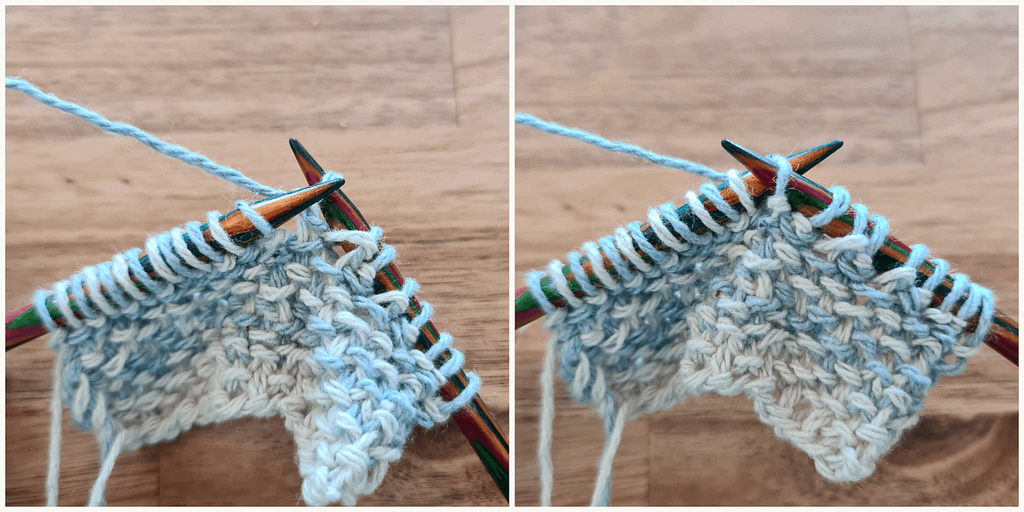
Pattern
Using color A: CO 91 stitches
Row 1: Using color A: *K1, slwyif 1* until 1 stitch before end of row, K1, turn
Row 2: Using color A: slwyib 1, *P1, slwyib 1* until end of row, turn
Row 3: Using color B: *K1, slwyif 1* until 1 stitch before end of row, K1, turn
Row 4: Using color B: slwyib 1, *P1, slwyib 1* until end of row, turn
Repeat rows 1-4 until the tea towel measures 22”, or you reached your desired length.
Repeat rows 1-2 once more.
Bind off using color A.
Weave in all the ends, and block.
Abbreviations
CO – Cast on
K – Knit
P – Purl
sl – Slip a stitch, unless indicated otherwise always slip purlwise
slwyif – Slip a stitch with the yarn in front
slwyib – Slip a stitch with the yarn in back
sts – stitches
This post contains affiliate links to products I recommend. If you purchase something from this page, I may receive a small percentage of the sale at no extra cost to you.
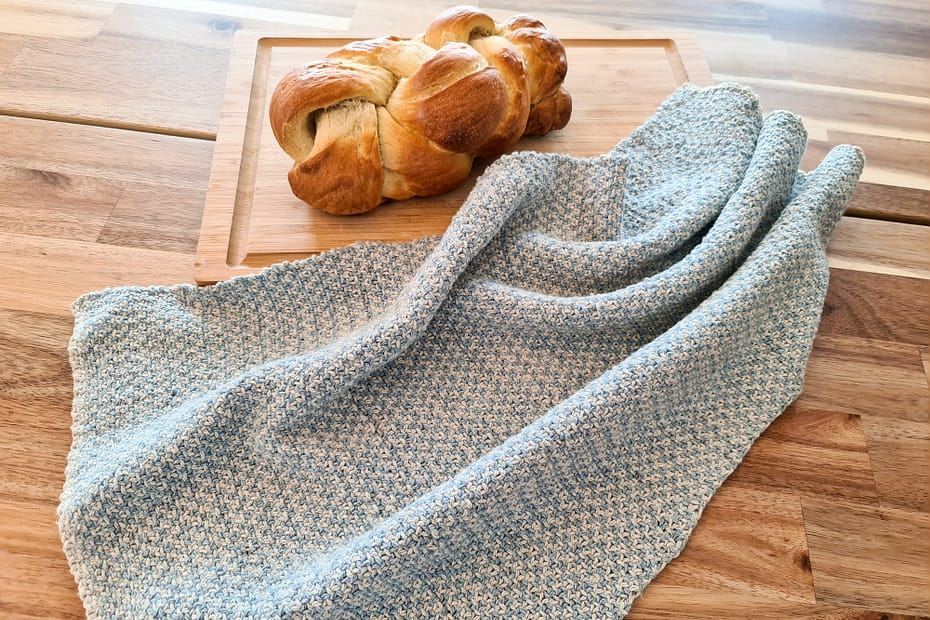

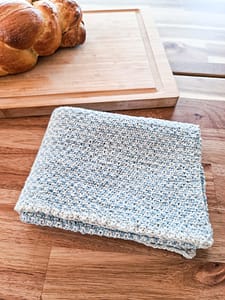
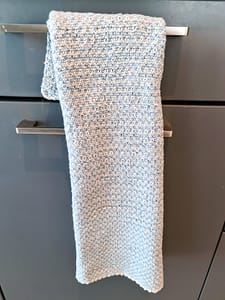
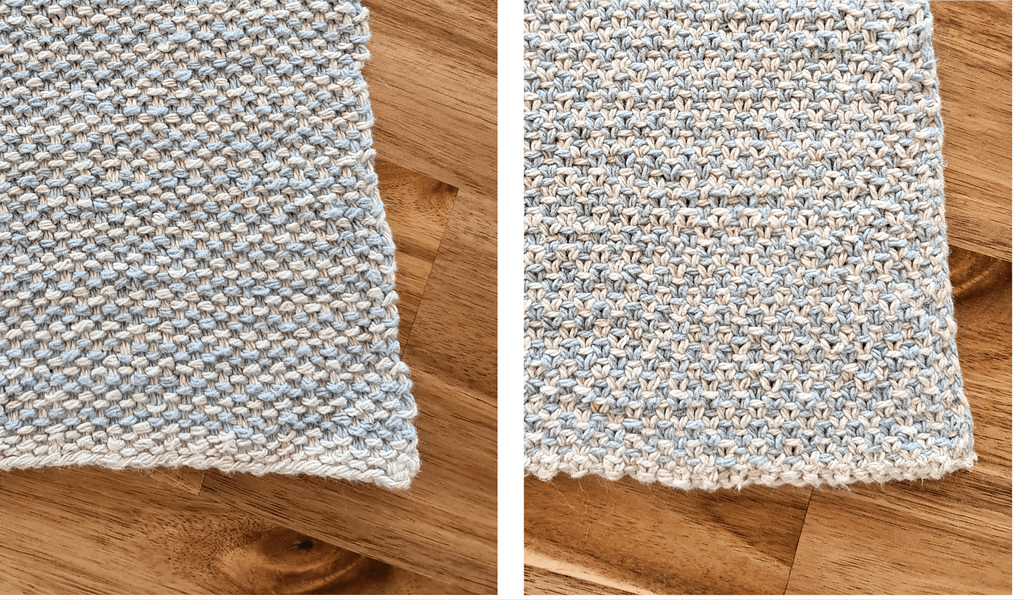
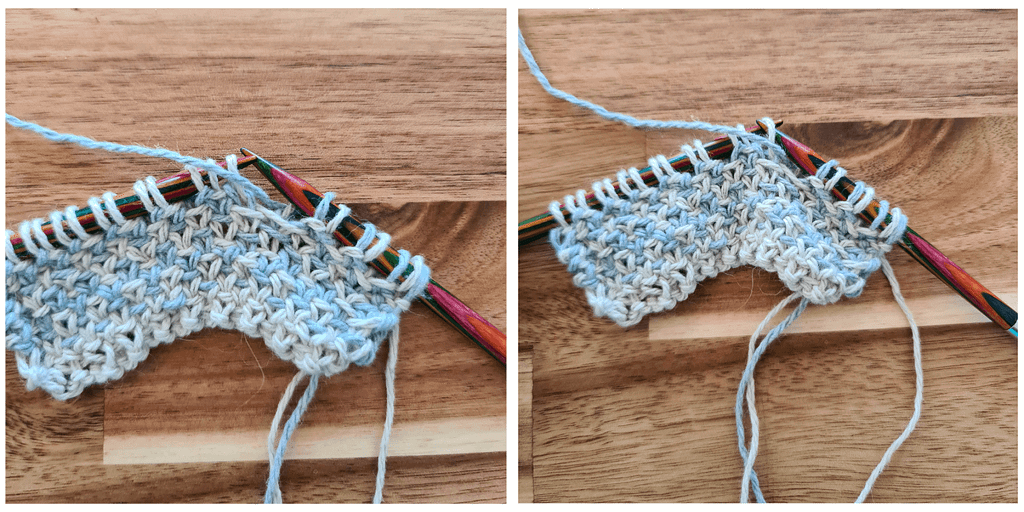
i can’t wait to knit the Cottage Tea Towel. However, you specify a 6mm/US10 knitting needle. It seems large for a DK yarn. Can you tell me why? Otherwise your instructions are very clear. to me.
Thanks in advance or your reply.
Hi Phyllis, the Cottage Tea Towel uses the Linen stitch to create the texture, and because the Linen stitch combines slipped and knitted stitches it creates a much denser fabric than stockinette if knit with the same needle size. I tested also with 4mm/US6 and 5mm/US8 needles but found the resulting fabric too stiff and hard to knit because the stitches were so tight. For me, the texture and drape with 6mm/US10 were just right! However, we all knit differently (and use different yarns), so use this as a starting point and experiment which needle size works best for you!
All the best,
steffi
Would casting on and binding off on smaller size needles help prevent the stretching I inevitably experience with cotton knits? My washcloths and dishtowels are sturdy but skew out of shape quickly.
Thank you.